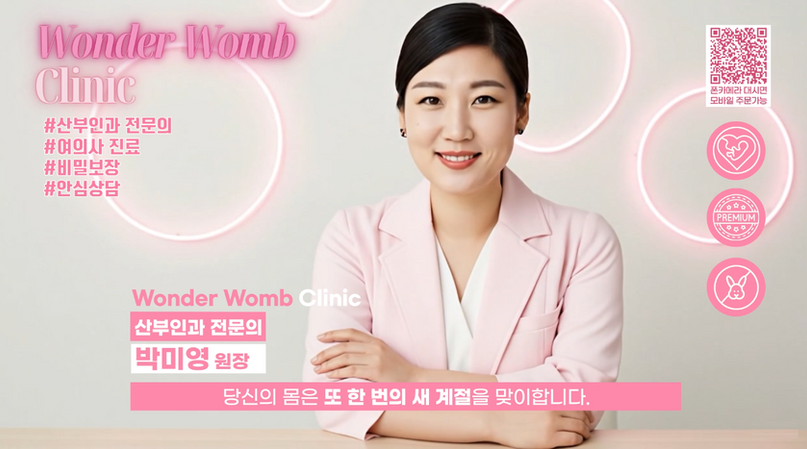YEONHO
JANG
Wonder Womb Clinic, 2025
5 min. single-channel video, color, sound


가상의 ‘자궁 리모델링 클리닉’을 무대로, 출산이 기술과 자본의 논리로 재편된 근미래의 풍경을 그린다. 영상은 과장된 홈쇼핑 광고의 형식을 빌려 진행된다. 반짝이는 로고와 경쾌한 멘트가 이어지는 화면 속에는 작가의 여권사진 이미지를 기반으로 AI가 생성한 다양한 ‘나’들이 등장한다.
산부인과 의사, 홈쇼핑 쇼호스트, 결혼해 임신을 준비하는 아내, 비혼으로 자가 줄기세포를 배양해 아이를 낳는 솔로맘, 완경을 앞두고 출산을 고민하는 여성, 노년이 되어 냉동 난자와 자궁 스캔 데이터를 복원해 아이를 품에 안는 여성, 그리고 출산의 경험만을 가상현실로 체험하는 여성까지—이들은 모두 ‘작가의 다른 가능성들’이자 기술이 만들어낸 평행적 자아들이다.
이들은 ‘퀵 임신 패키지’, ‘무자녀 라이프 케어’, ‘타임프리즈 유예 패키지’ 같은 미래형 출산 상품을 체험하며 등장한다. 각자의 욕망과 결핍, 선택의 순간들이 쇼핑화된 언어로 포장된다. AI로 생성된 장면들은 현실과 상상을 교차시키며, “경험하지 않았지만 경험한 듯한” 감각을 불러일으킨다—특히 작가 자신이 생성된 이미지 속에서 아이를 안고 있는 순간은, 생물학적 체험을 초월한 감정적 실재로 다가온다. 작가는 자신의 얼굴로 분기된 무수한 ‘가능성의 나’를 통해, 선택의 자유와 통제의 환상 사이 어딘가에 존재하는 여성의 몸과 정체성을 질문한다.
〈Wonder Womb Clinic〉은 ‘모성의 경험’이 상품처럼 거래되고, 여성의 몸이 업그레이드 가능한 플랫폼으로 재구성되는 세계를 유머와 아이러니 속에서 제시한다. 동시에 그것은 작가 자신의 생애주기적 불안과 선택의 가능성, 그리고 “살아보지 못한 삶들”에 대한 사유를 담은 자기 시뮬레이션이기도 하다.
Set in a fictional Wonder Womb Clinic, the work envisions a near-future landscape where childbirth is reorganized under the logic of technology and capital. Framed as a satirical home shopping broadcast, the video unfolds through dazzling graphics and exuberant sales pitches, featuring a series of AI-generated personas modeled after the artist’s passport photo.
These personas include an obstetrician, a home-shopping host, a married woman preparing for pregnancy, a single woman giving birth through self-cultivated stem cells, a woman approaching menopause and reconsidering motherhood, an elderly woman restoring her frozen egg and uterus-scan data to finally hold a child, and another who experiences childbirth vicariously through VR simulations. Each represents one of the artist’s “possible selves,” parallel identities born from technological imagination.
They appear as customers of futuristic maternity packages such as the “Quick Conception Plan,” “Childfree Life Care,” and “Time-Freeze Extension Program.” Their desires, anxieties, and life choices are repackaged in the language of consumerism. The AI-generated scenes blur the line between reality and imagination, evoking the uncanny sensation of “having experienced what one has not lived.” In particular, the image of the artist holding a newborn—though entirely synthesized—resonates as an emotionally real, embodied experience.
Through these innumerable “possible selves” branching from her own face, the artist questions the female body and identity that exist somewhere between the illusion of freedom and the mechanisms of control.
Wonder Womb Clinic presents a world where the experience of motherhood is commodified, and the female body becomes an upgradable platform. At once humorous and unsettling, the work is also a self-simulation—a reflection on the artist’s own cycle of aging, uncertainty, and the imagined lives she has not lived.












